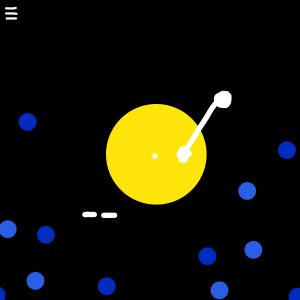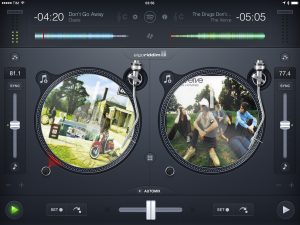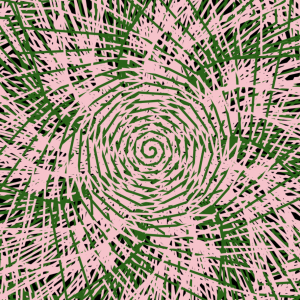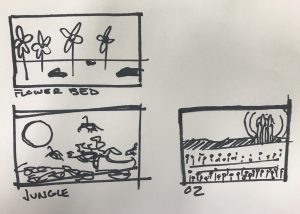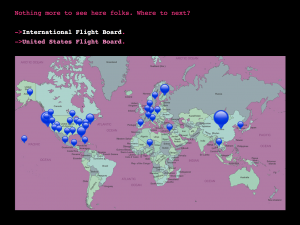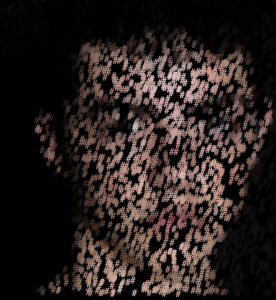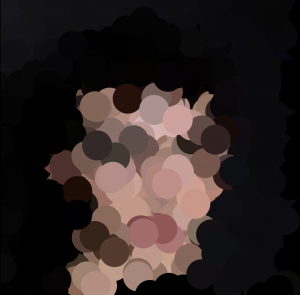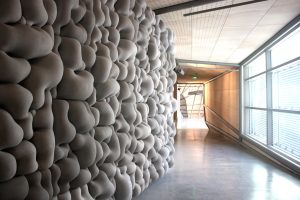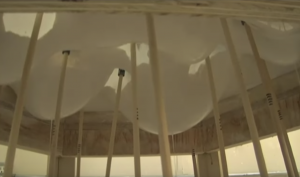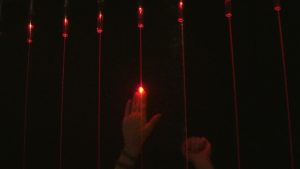/*
Connor McGaffin
Section C
cmcgaffi@andrew.cmu.edu
Assignment 11-B
*/
var option = 3; //starting option
var w = 500; //width
var h = 300; //height
var w2 = w / 2; //width / 2
var h2 = h / 2; //height / 2
var x = []; //bubble starting pos
var y = [];
var dx = []; //bubble direction
var dy = [];
var col = []; //bubble color
var np = 50; // how many particles
var nb = 50; //how many bubbles
var title = ["Valerie","Hound Dog", "Step"];
var artist = ["Amy Winehouse", "Elvis Presley", "Vampire Weekend"];
var currentSpot = 200; //current spot and lengths are to be later configured with p5.js addons and Spotify connectivity
var songLength = 300; // placeholder
var tempo = [96,175,78,0]; //stored tempo of songs
var amp = new p5.Amplitude(); //get amplitude
var particles = [];
function preload() {
img = loadImage("https://i.imgur.com/K3YQPRm.png"); //load spotify logo
amy = loadSound("https://courses.ideate.cmu.edu/15-104/f2018/wp-content/uploads/2018/12/amy.mp3"); //"Valerie" by Amy Winehouse
elvis = loadSound("https://courses.ideate.cmu.edu/15-104/f2018/wp-content/uploads/2018/12/elvis.mp3"); //"Hound Dog" by Elvis Presley
vw = loadSound("https://courses.ideate.cmu.edu/15-104/f2018/wp-content/uploads/2018/12/vw.mp3"); //"Step" by Vampire Weekend
}
function particleStep() {
this.x += this.dx;
this.y += this.dy / 5;
}
function particleDraw() { //draw particle
strokeWeight(this.s);
point(this.x, this.y);
}
function makeParticle(px, py, pdx, pdy, ps) { //create particle with starting pos and velocity
p = {x: px, y: py,
dx: pdx, dy: pdy, s: ps,
step: particleStep,
draw: particleDraw
}
return p;
}
function explode() {
for (var i = 0; i < np; i++) {// make a particle
fill(255);
stroke(255);
var p = makeParticle(w2, h2, random(-30,50), random(-30,50), random(5,10)); //initial location x/y quadrant velocity x/y, size
particles.push(p); // push the particle onto particles array
}
for (var i = 0; i < np; i++) { // for each particle
var p = particles[i];
p.step();
p.draw();
}
}
function record () {
noStroke();
fill(0);
ellipse (w2, h2 , 200); //vinyl
for (i = 0; i < 8; i++){
push();
noFill();
stroke(90);
strokeWeight(1);
ellipse(w2, h2, 190 - i * 30);
pop(); //texture
}
fill(200); // blue
ellipse(w2, h2, 75); //label
push();
translate(w2,h2);
rotate(frameCount * 5);
fill(150);
ellipse(15, 0, 5); //label spin
pop();
fill(255);
ellipse (w2, h2, 10); // peg
}
function tonearm () {
angleMode(DEGREES);
translate(w2 + 100, h2 - 100);
fill(255);
ellipse(0, 0, 30); //swivel
var tonearmPosition = map(currentSpot, 0, songLength, 0, 28);
push();
rotate(tonearmPosition);
push();
rectMode(CENTER);
rect(0,125, 12, 25); //cartridge
pop();
strokeWeight(3);
stroke(255);
line(0, 0, 0, 125); //bar
pop();
}
function header () {
image(img,10,10,20,20);
fill(255);
textSize(12);
text(title[option], 35, 20); //display title 12pt
textSize(9);
text(artist[option], 35, 30); //display artist 9pt
}
function setup() {
createCanvas(w, h);
for (i = 0; i < nb; i++) { //generate bubbles
x[i] = random(width); //randomly
y[i] = height; //at the bottom
dx[i] = random(-.5,.5); //that float sideways randomly
dy[i] = random(-2,-1); // and float virtically faster
col[i] = color(random(255)); //randomly filled in greyscale
}
}
function draw() {
background(10,0,0);
stroke(0);
strokeWeight(10);
explode();
var vol = amp.getLevel();
var bdiam = map(vol, 0, 1 , 5, 18);
var vdiam = map(vol, 0, 1, 200, 250); //vinyl amp diameter
for (i = 0; i < nb; i++) {
fill(col[i]);
noStroke();
ellipse(x[i], y[i], bdiam);
x[i] += dx[i];
y[i] += dy[i];
if (x[i] > width) { //bounce off right wall
x[i] = width - (x[i] - width);
dx[i] = -dx[i];
} else if (x[i] < 0) { //bounce off left wall
x[i] = -x[i];
dx[i] = -dx[i];
}
if (y[i] > height) { //bounce off bottom
y[i] = height - (y[i] - height);
dy[i] = -dy[i];
} else if (y[i] < 0) { //float off top, appear at bottom
y[i] = height;
}
}
push();
noStroke();
fill(180);
ellipse(w2,h2,vdiam,vdiam);
pop();
header();
record();
tonearm();
}
function mouseClicked() {
particles = []; //clear particles array
explode(); //create particle explosion
option ++; //next option when clicked
if(option > 3){
option = 0;
}
if(option == 0){
for(i = 0; i < nb; i++){
col[i] = color(0, 0, random(255)); //random blue
dx[i] = tempo[option] * random(-.1,.1) / 10; //horiz to tempo
}
vw.stop(); //stop "step"
amy.play(); // play "valerie"
}
if(option == 1){
for(i = 0; i < nb; i++){
col[i] = color(random(255),0,0); //random red
dx[i] = tempo[option] * random(-.1,.1) / 10; // horiz to tempo
}
amy.stop(); //stop "valerie"
elvis.play(); //play "hound dog"
}
if(option == 2){
for(i = 0; i < nb; i++){
col[i] = color(random(255)); //random greyscale
dx[i] = tempo[option] * random(-.1,.1) / 10; //horiz to tempo
}
elvis.stop(); //stop "hound dog"
vw.play(); //play "step"
}
if(option == 3){
vw.stop(); //stop "step"
for(i = 0; i < nb; i++){
col[i] = color(255); //bubbles fill white
dx[i] = random(-.1,.1); //horiz moment unrelated to tempo
}
}
}Redesigning Spotify Chromecast
This projects is a brief redesign of Spotify’s current Chromecast interface. Pictured below is the current state of the Spotify Chromecast player, which displays the current song, some controls, its information, its album cover, and the album covers of tracks adjacent to it in the queue.
With Spotify Chromecast so frequently being used while hosting a social event, I would argue that the current interface is distracting from the event, or redundant at the least. The current layout would easily enable guests to continuously check which song is coming next, and which songs have already played, freely guiding listeners out of the enjoying the music in the moment. In addition to this, much of the information on the screen is only necessary for the DJ to know, and it is already being provided on their phone’s interface.
With this being said, I looked to create a new interface for Spotify when used on Chromecast that would allow listeners to stay in the moment of the music, while still providing an complimentary atmosphere to that the of the social event.
As the user plays songs, the generated bubbles behind the record and one large bubble behind the record itself jump to the amplitude of the music. The small floating bubbles move horizontally on their upward waltz in speed relation to their tempo.
This project functions as a mock-up of my Chromecast Spotify player as a living environment. Unfortunately, I was not able to configure the p5.js with the Spotify API, as it was out of the scope of 15-104, and thus only these three preloaded songs may be queued. These tracks were chosen with the intent of providing a brief range of visual possibilities this program can generate.
Controls
- select anywhere on the canvas to play the next song, thus changing the color, size and flow of bubbles
![[OLD FALL 2018] 15-104 • Introduction to Computing for Creative Practice](https://courses.ideate.cmu.edu/15-104/f2018/wp-content/uploads/2020/08/stop-banner.png)

